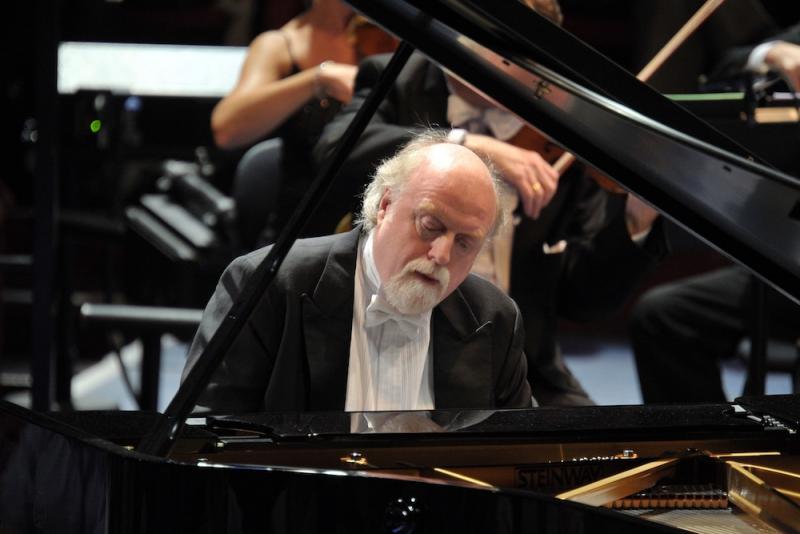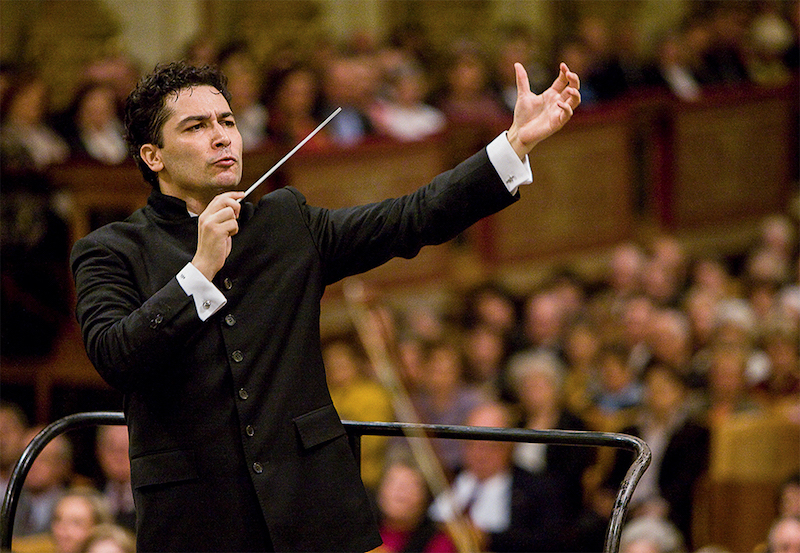Donohoe, LPO, Orozco-Estrada, RFH review – wit aplenty in rare Stravinsky | reviews, news & interviews
Donohoe, LPO, Orozco-Estrada, RFH review – wit aplenty in rare Stravinsky
Donohoe, LPO, Orozco-Estrada, RFH review – wit aplenty in rare Stravinsky
Creative programming deserved a better audience turn-out

I left this concert a bit depressed, but not because of anything I heard: rather, by the conservatism of London concert-goers. As London orchestras focus on programming the usual wall-to-wall Brahms, Beethoven and Mahler, the LPO was rewarded for their excursion from the well-trodden path by the punters staying away in droves from this imaginative programme.
As part of their Changing Faces: Stravinsky’s Journey year-long season, we heard two works from his 1920s output, paired with older pieces in the same vein of good humour and wit. Weber’s Konzertstück was a direct model for Stravinsky’s light-hearted Capriccio, and Schubert’s Third Symphony is full of youthful liveliness. But if audiences are scared away by the tonal, melodic world of Apollon Musagète then I dread to think of the empty rows in the Festival Hall when they reach Threni and the Aldous Huxley Variations in December.
It would be satisfying to report that those who weren’t there missed the best concert of the season, but unfortunately I can’t. There was some terrific playing, particularly in the second half, but also some fallible moments and dips in energy that were only fully overcome in the final item.
The eminent Peter Donohoe was soloist in both would-be piano concertos, continuing a recent trend I’ve noticed of soloists not contenting themselves with just the one concerto in a night. In Stravinsky’s Capriccio, written in 1929 for the composer himself to play, Donohoe was somewhat more authoritative than in the earlier Weber Konzertstück. He recorded the Stravinsky only last year, with the Hong Kong Philharmonic, and has got properly under the skin of the piece. He found a way of making its mercurial character hang together, whether leading the way with assertive gestures or being the music’s motor, in driving figuration, by taking each mood at face value. The string section was much reduced in size compared with the other pieces, and the scoring has a chamber-like clarity. Flautist Juliette Bausor was particularly effective in dancing her skittish lines around the piano. The Capriccio is not a masterwork, but it is genial and charming and well worth hearing. This, though, was the first time I’d heard it live, and I wonder how long it will be till the next.
The string section was much reduced in size compared with the other pieces, and the scoring has a chamber-like clarity. Flautist Juliette Bausor was particularly effective in dancing her skittish lines around the piano. The Capriccio is not a masterwork, but it is genial and charming and well worth hearing. This, though, was the first time I’d heard it live, and I wonder how long it will be till the next.
The Weber Konzertstück is a more traditional virtuoso vehicle, if unconventionally structured as a single movement, sub-divided into four sections. Here Donohoe’s playing was not flawless but it was exciting, although I didn’t envy him the repeated and finger-shredding triple glissandos. The best bit was the solo piano entrance, where his articulation of a long melody over staccato chords was delightfully weighted. But throughout I had a slight uneasiness about his playing that was banished in the Stravinsky.
While Donohoe took centre stage for these middle items, conductor Andrés Orozco-Estrada (pictured above) was firmly in charge for the rest. In Stravinsky’s Apollon Musagète, the opening number, he did his best to give the music life but the playing felt a bit flat: I felt the orchestra was fighting the acoustic, and that this piece particularly needed a more generous hall. Most effective were the fuller, more resonant passages, such as the noble chordal refrain of the terrific "Variation of Apollo". Leader Pieter Schoeman was very good in his extended solos, and a reassuring presence throughout.
But both conductor and orchestra were at their best in the final piece, Schubert’s Third Symphony. Written when the composer was only 18, and influenced by Haydn, it has a breezy self-confidence that was captured beautifully. Orozco-Estrada was at his most animated here, evincing strong interpretative ideas about the music, such as the sustaining the final clarinet note beyond the rest of the orchestra in the second movement, or taking the helter-skelter last movement very fast and nimble. Principal clarinet Giovanni Punzi found the wit in his several solo moments and timpanist Simon Carrington was suitably crisp. When the symphony finished I’d have happily heard it all over again.
rating
Explore topics
Share this article
The future of Arts Journalism
You can stop theartsdesk.com closing!
We urgently need financing to survive. Our fundraising drive has thus far raised £49,000 but we need to reach £100,000 or we will be forced to close. Please contribute here: https://gofund.me/c3f6033d
And if you can forward this information to anyone who might assist, we’d be grateful.

Subscribe to theartsdesk.com
Thank you for continuing to read our work on theartsdesk.com. For unlimited access to every article in its entirety, including our archive of more than 15,000 pieces, we're asking for £5 per month or £40 per year. We feel it's a very good deal, and hope you do too.
To take a subscription now simply click here.
And if you're looking for that extra gift for a friend or family member, why not treat them to a theartsdesk.com gift subscription?
more Classical music
 theartsdesk at the New Ross Piano Festival - Finghin Collins’ musical rainbow
From revelatory Bach played with astounding maturity by a 22 year old to four-hand jazz
theartsdesk at the New Ross Piano Festival - Finghin Collins’ musical rainbow
From revelatory Bach played with astounding maturity by a 22 year old to four-hand jazz
 Kanneh-Mason, Britten Sinfonia, Shave, Milton Court - a grin and a big beaming smile
A pair of striking contemporary pieces alongside two old favourites
Kanneh-Mason, Britten Sinfonia, Shave, Milton Court - a grin and a big beaming smile
A pair of striking contemporary pieces alongside two old favourites
 First Person: Manchester Camerata's Head of Artistic Planning Clara Marshall Cawley on questioning the status quo
Five days of free events with all sorts of audiences around Manchester starts tomorrow
First Person: Manchester Camerata's Head of Artistic Planning Clara Marshall Cawley on questioning the status quo
Five days of free events with all sorts of audiences around Manchester starts tomorrow
 Goldscheider, Brother Tree Sound, Kings Place review - music of hope from a young composer
Unusual combination of horn, strings and electronics makes for some intriguing listening
Goldscheider, Brother Tree Sound, Kings Place review - music of hope from a young composer
Unusual combination of horn, strings and electronics makes for some intriguing listening
 theartsdesk Q&A: composer Donghoon Shin on his new concerto for pianist Seong-Jin Cho
Classical music makes its debut at London's K-Music Festival
theartsdesk Q&A: composer Donghoon Shin on his new concerto for pianist Seong-Jin Cho
Classical music makes its debut at London's K-Music Festival
 Helleur-Simcock, Hallé, Wong, Bridgewater Hall, Manchester review - moving lyricism in Elgar’s concerto
Season opener brings lyrical beauty, crisp confidence and a proper Romantic wallow
Helleur-Simcock, Hallé, Wong, Bridgewater Hall, Manchester review - moving lyricism in Elgar’s concerto
Season opener brings lyrical beauty, crisp confidence and a proper Romantic wallow
 Kohout, Spence, Braun, Manchester Camerata, Huth, RNCM, Manchester review - joy, insight, imagination and unanimity
Celebration of the past with stars of the future at the Royal Northern College
Kohout, Spence, Braun, Manchester Camerata, Huth, RNCM, Manchester review - joy, insight, imagination and unanimity
Celebration of the past with stars of the future at the Royal Northern College
 Jansen, LSO, Pappano, Barbican review - profound and bracing emotional workouts
Great soloist, conductor and orchestra take Britten and Shostakovich to the edge
Jansen, LSO, Pappano, Barbican review - profound and bracing emotional workouts
Great soloist, conductor and orchestra take Britten and Shostakovich to the edge
 Jakub Hrůša and Friends in Concert, Royal Opera review - fleshcreep in two uneven halves
Bartók kept short, and a sprawling Dvořák choral ballad done as well as it could be
Jakub Hrůša and Friends in Concert, Royal Opera review - fleshcreep in two uneven halves
Bartók kept short, and a sprawling Dvořák choral ballad done as well as it could be
 Hadelich, BBC Philharmonic, Storgårds, Bridgewater Hall, Manchester review - youth, fate and pain
Prokofiev in the hands of a fine violinist has surely never sounded better
Hadelich, BBC Philharmonic, Storgårds, Bridgewater Hall, Manchester review - youth, fate and pain
Prokofiev in the hands of a fine violinist has surely never sounded better
 Monteverdi Choir, ORR, Heras-Casado, St Martin-in-the-Fields review - flames of joy and sorrow
First-rate soloists, choir and orchestra unite in a blazing Mozart Requiem
Monteverdi Choir, ORR, Heras-Casado, St Martin-in-the-Fields review - flames of joy and sorrow
First-rate soloists, choir and orchestra unite in a blazing Mozart Requiem
 Cho, LSO, Pappano, Barbican review - finely-focused stormy weather
Chameleonic Seong-Jin Cho is a match for the fine-tuning of the LSO’s Chief Conductor
Cho, LSO, Pappano, Barbican review - finely-focused stormy weather
Chameleonic Seong-Jin Cho is a match for the fine-tuning of the LSO’s Chief Conductor

Add comment